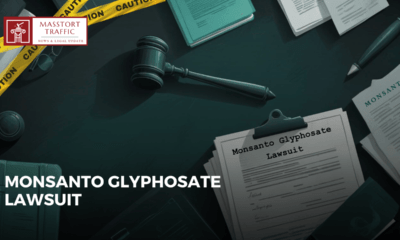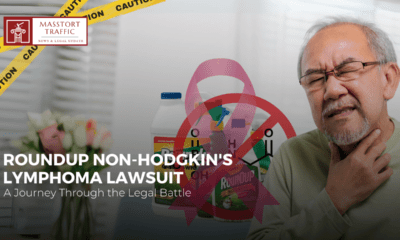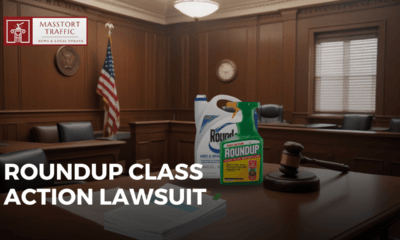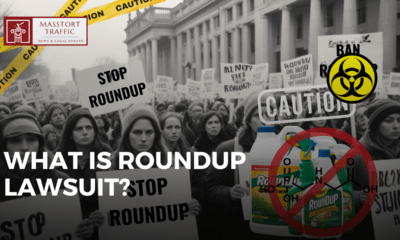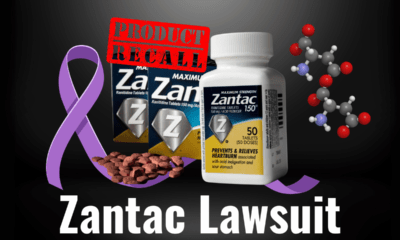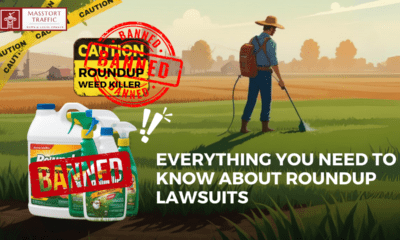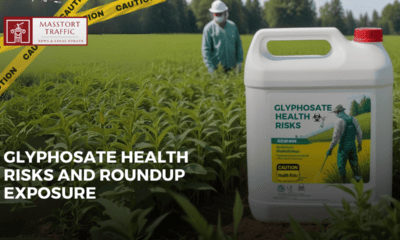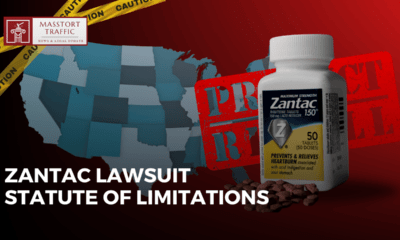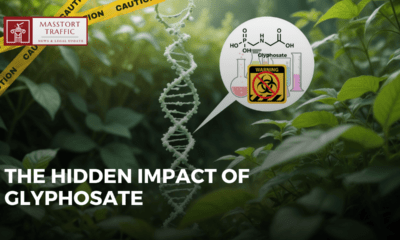Mass Torts Lawsuit
Best Law Firm for Roundup Lawsuits: Do You Qualify to File a Roundup Lawsuit?

Introduction
Imagine this: You or a loved one has been regularly exposed to Roundup weed killer and now faces a serious health challenge. You’re not alone. Roundup, the popular herbicide produced by Monsanto (now Bayer AG), is linked to severe health risks, including cancer. As more people seek justice, finding the right legal representation becomes crucial.
In this blog, we’ll guide you through the process of selecting the best law firm for Roundup lawsuits, explain how a Roundup lawyer can help you secure compensation, and provide an overview of the health risks associated with Roundup exposure. If you’ve been affected, understanding your legal options is the first step towards achieving justice. Let’s explore how you can navigate this complex situation with the help of experienced attorneys.
Table of Contents
Roundup Lawsuits: An Overview
Roundup weed killer, widely used for decades, has come under intense scrutiny due to its active ingredient, glyphosate. Glyphosate has been linked to serious health issues, particularly non-Hodgkin’s lymphoma (NHL), a type of cancer that affects the lymphatic system.
In 2015, the International Agency for Research on Cancer (IARC) classified glyphosate as a “probable human carcinogen,” which sparked a wave of lawsuits against Monsanto. Thousands of individuals have claimed that their cancer diagnosis was due to exposure to Roundup. This led to significant legal battles and settlements.
In response to these claims, Monsanto, which is now part of Bayer AG, faced numerous legal challenges. Notably, in 2020, Bayer agreed to a massive $10 billion settlement to resolve most of the Roundup lawsuits. Despite this, new cases continue to be filed, highlighting ongoing concerns about glyphosate’s safety.
Roundup Lawsuit Update: Lawyers Are Still Filing Lawsuits Against Monsanto
The legal battle against Monsanto (Bayer AG) is far from over. Even after major settlements, lawyers are still actively filing lawsuits on behalf of individuals who allege that Roundup exposure caused their health issues. Recent legal actions reflect continued skepticism about glyphosate’s safety and the company’s practices.
In recent trials, verdicts have varied, with some plaintiffs securing substantial settlements while others face challenges. For instance, a Philadelphia jury recently awarded nearly $3.5 million to a woman claiming Roundup caused her cancer, marking Bayer’s fifth consecutive loss in a Roundup trial.
This ongoing litigation underscores the persistent concerns about Roundup and the need for legal recourse for those affected. If you believe you have been harmed by Roundup, seeking legal advice remains crucial.
How Experienced Roundup Lawyers Can Help You
Navigating a Roundup lawsuit requires a team of skilled attorneys who understand the complexities of mass tort litigation. Experienced Roundup lawyers are equipped to handle the intricacies of these cases, offering critical support and guidance throughout the legal process.
Experienced Roundup Lawyers Can Help You With These Key Actions:
- Gather Evidence: They will help you collect and present compelling evidence, including medical records, work history, and proof of Roundup usage.
- Assess Damages: They can evaluate the extent of your damages, including medical expenses, lost wages, and pain and suffering.
- Negotiate Settlements: Skilled lawyers negotiate with large corporations to secure fair compensation for your suffering.
- Navigate Legal Challenges: They have the expertise to handle complex legal systems and ensure that your case is managed effectively.
With decades of experience in handling similar cases, our attorneys are dedicated to seeking justice for victims of Roundup exposure.
Do You Qualify for the Roundup Cancer Lawsuit?
If you or a loved one has been diagnosed with non-Hodgkin’s lymphoma or another related health condition after regular exposure to Roundup, you may be eligible to file a lawsuit. Qualification for a Roundup lawsuit typically involves:
- Diagnosis: Confirming a diagnosis of non-Hodgkin’s lymphoma or other related cancers.
- Exposure: Demonstrating regular use of Roundup or similar glyphosate-containing products.
- Medical Link: Establishing a connection between Roundup exposure and the cancer diagnosis.
Consulting with a knowledgeable Roundup lawyer can help determine your eligibility and guide you through the process of filing a claim.

Tips for Selecting the Best Law Firm in Roundup Lawsuits
Choosing the right law firm for your Roundup lawsuit is crucial. Here are some key factors to consider:
- Expertise in Mass Tort Litigation: Look for firms with a proven track record in handling mass tort cases, particularly those involving glyphosate and Roundup.
- Client-Centric Approach: The best firms prioritize client needs, offering personalized support and clear communication.
- Resource Availability: Ensure the firm has the financial and technological resources to manage complex litigation.
- Guidance Through the Legal Process: Choose a firm that provides comprehensive guidance through each stage of the legal process.
Selecting a law firm with these attributes can significantly impact the success of your case.
Finding the Best Law Firm for Roundup Lawsuits
When dealing with Roundup-related legal issues, selecting the best law firm for Roundup lawsuits is crucial. The right law firm can significantly impact the outcome of your case. Here’s how to find the best law firm for Roundup lawsuits and what to expect:
- Experience and Expertise: Look for a firm with a proven track record in handling Roundup cases. The best law firm for Roundup lawsuits will have experience specifically with glyphosate-related claims.
- Client Testimonials and Reviews: Research client feedback to ensure the firm has a reputation for successfully representing clients in Roundup lawsuits.
- Legal Resources and Support: A top-tier law firm will have access to experts and resources that can strengthen your case.
- Personalized Approach: The best law firm for Roundup lawsuits will provide tailored legal strategies and support throughout the legal process.
- Successful Settlements and Verdicts: Evaluate the firm’s history of settlements and court victories in Roundup lawsuits to gauge their effectiveness.
Choosing the best law firm for Roundup lawsuits can make all the difference in securing the compensation you deserve. Make sure to thoroughly vet your options and select a firm that aligns with your needs and goals.
Gathering Evidence for Roundup Cases
In Roundup lawsuits, solid evidence is essential. Key types of evidence include:
- Medical Records: Documentation of your diagnosis and treatment history.
- Work Records: Evidence of your employment history and use of Roundup.
- Receipts and Proof of Purchase: Records showing the purchase and use of Roundup.
- Witness Statements: Statements from individuals who can attest to your exposure.
A skilled lawyer will assist in gathering and organizing this evidence to build a strong case.
Assessing Damages in Roundup Cancer Claims
Damages in Roundup lawsuits can cover a range of losses, including:
- Medical Bills: Costs of treatment and ongoing care.
- Future Medical Expenses: Anticipated future medical needs.
- Lost Wages: Income lost due to illness.
- Pain and Suffering: Compensation for physical and emotional distress.
- Loss of Enjoyment of Life: Impact on your quality of life.
An experienced attorney will help calculate these damages and ensure that you receive appropriate compensation.

If you or a loved one has been diagnosed with non-Hodgkin’s lymphoma or another cancer after being exposed to Roundup, taking legal action is a crucial step. Contact our team of dedicated Roundup lawyers today for a free consultation to discuss your case, explore your options, and begin your journey toward justice.
Mass Torts Lawsuit
Congress Investigates Uber’s Handling of Sexual Assault Claims

When Congress investigates Uber and its role in handling sexual assault claims, survivors and their families need clarity, reassurance, and a path forward after trauma.
Table of Contents
What does Congress investigates Uber really mean for riders?
Between 2017 and 2022, Uber logged approximately 400,181 reports of sexual assault or misconduct during U.S. trips — or roughly one report every eight minutes. House Oversight Committee+2TorHoerman Law+2
When Congress investigates Uber’s safety practices, it signals that your experience is not isolated — and that accountability may follow.
DID YOU KNOW?
Why Congress investigates Uber: the facts behind the inquiry
Oversight and scrutiny of Uber’s safety protocols
A U.S. House sub-committee chair sent a letter to Uber’s CEO seeking details on how the company:
- screens drivers for past misconduct
- investigates and reports sexual assault complaints
- discloses data to riders and regulators. House Oversight Committee
Such scrutiny means that when Congress investigates Uber, it casts a spotlight on system-wide responsibility — not just the individual driver.
Lawsuits piling up amid safety concerns
Thousands of passengers claim Uber failed to keep them safe—alleging inadequate background checks, lack of video safety features and weak incident response. TorHoerman Law+1
When Congress investigates Uber, it may influence how these lawsuits move forward.
What riders should know about case counts
- The federal multidistrict litigation (MDL) against Uber involves many sexual assault claims. Federal Lawyer
- Uber reported 2,717 serious sexual assault category incidents during 2021–22 in the U.S. Reuters
This means if you were harmed while riding, your claim may be part of broader systemic issues.
If Congress investigates Uber – What this means for you as a survivor
You’re not alone
When Congress investigates Uber, it amplifies the voices of many who suffered similar harm — reinforcing that your experience has broader relevance.
Evidence and claims: why documentation matters
To build your strongest case:
- Keep ride receipts and trip details (date/time, driver name, route). Consumer Notice, LLC
- Preserve medical records, photos, and any reporting you made.
- Note any statements made by Uber or the driver after the incident.
Legal options and next steps
When Congress investigates Uber, legal momentum can shift. For options:
- Consult with a qualified rideshare-injury attorney.
- Ask if your claim can join the MDL or be filed separately.
- Consider whether you were kept in mandatory arbitration (Uber changed this policy in 2018). Helping Survivors
What to ask your attorney when Congress investigates Uber
- Have you handled rideshare assault cases before?
- Will my case join the MDL or be filed alone?
- What evidence do I still need to gather?
- What compensation might be possible (medical costs, trauma, lost wages)?
- How will Congress’s inquiry impact Uber-related cases?
💡 Remember: when Congress investigates Uber, media coverage and legal attention increase — that can benefit your case.
Ready to Take the First Step Toward Justice?
Speak with our trusted legal team today. Your Free, Confidential, No-Obligation Case Evaluation is waiting — and it only takes a minute to begin.
GET YOUR FREE CASE EVALUATION NOW →Prefer to talk now? Call (+1) 210-940-9440 Today
 100% Secure & Confidential
|
100% Secure & Confidential
|
 No Obligation Consultation
No Obligation ConsultationBy submitting this form, you agree to be contacted by a trusted legal partner for a free case review. This does not create an attorney-client relationship. Confidential and secure.
Conclusion
When Congress investigates Uber, it signals a turning point for rideshare safety and accountability. If you or a loved one were harmed during an Uber trip, now is the time to speak with an experienced attorney who understands these emerging legal trends — and can help you fight for the justice and healing you deserve.
EXTERNAL SOURCES & REFERENCES
- U.S. House Committee on Oversight and Accountability – “Mace Seeks Information from Uber on Safety Protocols to Prevent Sexual Assault and Misconduct”
🔗 https://oversight.house.gov/release/mace-seeks-information-from-uber-on-safety-protocols-to-prevent-sexual-assault-and-misconduct/ - Reuters – “Uber Found Not Liable in First U.S. Trial Over Driver Sexual Assault Claims” (October 1, 2025)
🔗 https://www.reuters.com/legal/government/uber-found-not-liable-first-us-trial-over-driver-sexual-assault-claims-2025-10-01/ - Consumer Notice.org – “Rideshare Lawsuits: Legal Action Against Uber and Lyft”
🔗 https://www.consumernotice.org/legal/rideshare-lawsuits/ - Helping Survivors.org – “Uber Sexual Assault Lawsuit: Know Your Rights and Legal Options”
🔗 https://helpingsurvivors.org/rideshare-sexual-assault/uber-lawsuit/
“Justice for your child has a deadline. In Rideshare Sexual Abuse lawsuits, delay equals denial. Act now.”
— Visit MassTortTraffic.com or Call (+1) 210-940-9440
Mass Torts Lawsuit
Choosing the Right Attorney for Your Rideshare Assault Claim

Experiencing an assault during a rideshare is a profound violation of trust. If you are a survivor, finding the right rideshare assault lawyer is the first, crucial step toward healing and holding the responsible parties accountable.
You may feel overwhelmed, confused, and unsure where to turn. You are not alone, and you have legal rights.
This guide will help you understand what to look for in an attorney to ensure your case is handled with the compassion, confidentiality, and aggression it deserves.
Table of Contents
Why You Need a Specialized Rideshare Assault Lawyer
A rideshare assault case is not a typical personal injury claim, like a car accident. It is a complex legal matter that often involves two components: the criminal act of the driver and the corporate negligence of the rideshare company, such as Uber or Lyft.
These multi-billion dollar companies have powerful legal teams dedicated to minimizing their financial responsibility. They may try to argue the driver was an “independent contractor” to avoid liability for:
- Negligent hiring practices
- Failure to conduct adequate background checks
- Ignoring previous complaints against the driver
- Inadequate safety features in their app
You need an attorney who specifically understands these complex arguments and has the resources to fight them. A general practice lawyer may not have the specific experience required to navigate the sensitive nature of sexual assault litigation combined with corporate liability law.
Essential Qualities of the Right Legal Team
When you are vetting potential attorneys, you are looking for a unique combination of skill and sensitivity. This person will be your advocate, and you must be able to trust them with the most personal details of your trauma.
A Proven Track Record with Sexual Assault Cases
This is the most critical factor. Ask any potential lawyer if they have experience representing survivors of sexual assault, specifically.
A trauma-informed lawyer understands:
- Confidentiality: They will know how to protect your privacy, potentially filing the lawsuit using a “Jane Doe” or “John Doe” pseudonym to shield your identity from the public.
- Sensitive Communication: They will know how to discuss the details of your case without causing re-traumatization.
- The “Discovery” Process: They will fiercely protect you during depositions (out-of-court testimony) and fight against defense tactics designed to “blame the victim.”
Your attorney should prioritize your well-being just as much as the financial outcome of your case.
Resources to Challenge Large Corporations
Rideshare companies like Uber and Lyft will not settle a case easily. They will use their vast resources to delay and deny claims.
Your chosen law firm must have the financial standing and investigative resources to:
- Hire industry-leading experts (e.g., security experts, psychologists).
- Conduct deep investigations into the driver’s history and the company’s hiring protocols.
- Manage a complex and lengthy legal battle (litigation) if the company refuses to offer a fair settlement.
A Contingency-Fee Agreement
You should never have to pay any money upfront to get justice.
DID YOU KNOW?
A reputable rideshare assault lawyer will operate on a contingency-fee basis. This means they only get paid a percentage of the compensation they recover for you, after they win your case. If they do not win, you owe them no attorney’s fees.
This structure ensures your lawyer is fully motivated to secure the maximum possible compensation for you.
Understanding the Stakes: Why Your Voice Matters
The trauma of sexual violence is immense. In the United States, 1 out of every 6 women has been the victim of an attempted or completed rape in her lifetime. [Source: https://www.rainn.org/statistics/scope-problem]
When this violence occurs in a situation where you are supposed to be safe—like a rideshare—the sense of betrayal is devastating.
Filing a civil claim is not just about money. It is about holding every responsible party accountable. It is about forcing these powerful companies to change their policies, improve their background checks, and protect future riders. Your case can be the catalyst that prevents this from happening to someone else.
An experienced lawyer helps you seek compensation for damages, which may include:
- Medical bills (present and future)
- Psychological counseling and therapy
- Lost wages and diminished earning capacity
- Pain, suffering, and emotional distress
- Punitive damages (designed to punish the company for gross negligence)
Key Questions to Ask During Your Free Consultation
Most personal injury law firms offer a 100% free, confidential case evaluation. This is your opportunity to interview the lawyer—not the other way around.
Come prepared with these questions to find the right fit:
- Have you specifically handled rideshare assault cases against Uber or Lyft? (Look for specific experience, not just general assault cases.)
- What is your approach to protecting my privacy and confidentiality? (Will they file the case under a pseudonym?)
- Who will be my primary point of contact at the firm? (Will you be speaking to the lawyer you’re meeting, or passed to a paralegal?)
- What is your fee structure? (Confirm it is a contingency-fee.)
- What do you see as the main strengths and weaknesses of my case? (Look for an honest, realistic answer.)
- How will you support me if this case goes to trial?
Trust your intuition. The right attorney will make you feel heard, respected, and believed. If you feel dismissed, rushed, or judged, that is not the right lawyer for you.
Ready to Take the First Step Toward Justice?
Speak with our trusted legal team today. Your Free, Confidential, No-Obligation Case Evaluation is waiting — and it only takes a minute to begin.
GET YOUR FREE CASE EVALUATION NOW →Prefer to talk now? Call (+1) 210-940-9440 Today
 100% Secure & Confidential
|
100% Secure & Confidential
|
 No Obligation Consultation
No Obligation ConsultationBy submitting this form, you agree to be contacted by a trusted legal partner for a free case review. This does not create an attorney-client relationship. Confidential and secure.
Conclusion
You have already survived the unthinkable; you do not have to fight for justice alone. Choosing the right rideshare assault lawyer is the most important decision you can make right now. Do not wait—take the first step to protect your rights today.
External Resources
- RAINN (Rape, Abuse & Incest National Network): The nation’s largest anti-sexual violence organization, offering statistics and support. https://www.rainn.org
- U.S. Department of Justice | Office on Violence Against Women (OVW): Provides federal leadership in developing responses to violence against women. https://www.justice.gov/ovw
- Victim Connect Resource Center: A confidential helpline for all crime victims in the United States. https://victimconnect.org/
“Justice for your child has a deadline. In Rideshare Sexual Abuse lawsuits, delay equals denial. Act now.”
— Visit MassTortTraffic.com or Call (+1) 210-940-9440
Mass Torts Lawsuit
How Leaked Documents Reveal Uber’s Safety Failures

When you order a rideshare, you place your trust—and your safety—in the hands of a massive corporation. You expect to be safe. But the Uber leaked documents, known globally as “The Uber Files,” paint a disturbing picture. They suggest the company may have prioritized aggressive global growth over protecting its passengers and drivers, potentially putting millions at risk.
For those who have been injured, assaulted, or have lost loved ones in a rideshare incident, this news is more than a headline; it’s a profound betrayal. It suggests the harm you suffered may not have been an isolated incident, but the result of a system designed to look the other way.
Table of Contents
Here is the legal blog content, optimized according to your detailed script.
1) META
- Meta Title (≤ 60 chars): Uber Leaked Documents: An Urgent Look at Safety Failures
- URL Slug:
uber-leaked-documents-safety-failures - Meta Description (115–160 chars): The Uber leaked documents reveal shocking safety risks. If you were harmed, you have rights. Get your free, confidential case review now. Call (+1) 210-940-9440.
- Focused Keyword:
Uber leaked documents - SEO TAGS:
Uber leaked documents,Uber safety failures,The Uber Files,Uber lawsuit,Uber assault lawsuit,Uber passenger safety,Uber driver safety,rideshare assault claim,corporate negligence,Uber kill switch,Get a free case review,personal injury lawyer,Uber accident claim,rideshare negligence
2) FULL BLOG BLOCK (998 words)
How Leaked Documents Reveal Uber’s Safety Failures
When you order a rideshare, you place your trust—and your safety—in the hands of a massive corporation. You expect to be safe. But the Uber leaked documents, known globally as “The Uber Files,” paint a disturbing picture. They suggest the company may have prioritized aggressive global growth over protecting its passengers and drivers, potentially putting millions at risk.
For those who have been injured, assaulted, or have lost loved ones in a rideshare incident, this news is more than a headline; it’s a profound betrayal. It suggests the harm you suffered may not have been an isolated incident, but the result of a system designed to look the other way.
What Are “The Uber Files”?
In 2022, a massive trove of more than 124,000 internal Uber records (from 2013-2017) was leaked by a former top lobbyist, Mark MacGann. This leak was shared with The Guardian and the International Consortium of Investigative Journalists (ICIJ), which analyzed the data.
The documents include emails, text messages, and presentations, revealing a corporate playbook that allegedly valued disruption over compliance.
According to the ICIJ, the files detail:
- Aggressive Lobbying: Secret meetings with prime ministers, presidents, and government officials to influence laws in Uber’s favor.
- Bypassing Regulations: Knowingly launching in markets in defiance of local taxi laws and regulations.
- Obstructing Investigations: Using sophisticated technology to thwart police raids and prevent regulators from accessing company data.
[Source: https://www.icij.org/investigations/uber-files/]
This wasn’t just about business competition. This alleged pattern of deception and regulatory evasion directly ties into the company’s approach to safety.
The “Kill Switch”: A Tool to Evade Law Enforcement
One of the most alarming revelations from the Uber leaked documents was the existence of a “kill switch.” This tool, reportedly codenamed “Ripley,” was allegedly used during police raids on Uber’s international offices.
DID YOU KNOW?
When activated, the kill switch would effectively cut access from that office’s computers to the main company servers. This prevented investigators from seeing sensitive data on company operations, safety incidents, or driver information.
Why This Matters for Passenger and Driver Safety
This wasn’t just about protecting trade secrets. Police and regulators investigate serious crimes, including physical assaults, sexual assaults, and fatal accidents.
By allegedly deploying a “kill switch,” the company may have obstructed active criminal investigations. It demonstrates a culture that, when faced with legal oversight, chose to hide information rather than cooperate. For victims seeking justice, this practice is a devastating blow. It raises the question: What else were they trying to hide?
Prioritizing Growth Over Safety: The Real-World Impact
The Uber Files suggest a corporate mindset fixated on “blitzscaling”—growing as fast as possible, whatever the cost. This aggressive expansion allegedly came at the expense of proper driver vetting and passenger safety protocols.
The Link Between Lax Vetting and Passenger Assaults
To fuel its rapid growth, Uber needed millions of drivers, fast. In many markets, this meant pushing back against strict background check requirements, such as fingerprint-based checks, that were standard for traditional taxi services.
While Uber has since updated many of its safety features, the culture exposed in the leaks is critical. The documents show executives were aware of the risks, including violence and assaults, but continued their aggressive tactics.
This alleged failure to prioritize safety has had devastating, real-world consequences.
- In its 2019-2020 U.S. Safety Report, Uber itself disclosed 3,824 reports of the five most severe categories of sexual assault. [Source: https://www.uber.com/newsroom/us-safety-report-2022]
- Thousands of passengers and drivers have reported physical assaults, carjackings, and harassment.
When a corporation is aware of safety risks—such as the risk of assault—but fails to implement reasonable safety measures (like robust background checks), it may be held legally responsible for the harm that results.
The Dangers for Drivers
The leaks also highlight the risks faced by drivers. Uber’s aggressive push into new, sometimes volatile markets, allegedly put drivers on the front lines with little protection. Drivers were classified as independent contractors, which critics argue was a way for Uber to avoid the costs of employment, including safety training, benefits, and liability insurance.
The documents reportedly show that when drivers faced violence, the company’s primary response was often focused on managing the “PR” fallout rather than addressing the root causes of the danger.
How the Uber Leaked Documents Can Impact Your Legal Claim
If you or a loved one was harmed while using Uber, these leaked documents are not just corporate gossip. They are potentially powerful evidence in a personal injury lawsuit.
To win a negligence lawsuit, your attorney must generally prove four things:
- Duty: Uber had a legal “duty of care” to keep you reasonably safe.
- Breach: Uber breached that duty through its actions or inaction (e.g., poor background checks, ignoring complaints).
- Causation: This breach directly caused your injuries.
- Damages: You suffered actual harm (medical bills, emotional distress, etc.).
The Uber Files are most powerful for proving the “breach” of duty. They can help an attorney establish a pattern of negligence. They show what the company’s executives knew, when they knew it, and what they chose to do (or not do) with that information.
This evidence can transform a case from a “he said, she said” incident into a clear demonstration of corporate-wide failure to protect the public.
[Learn More: Understanding Your Rights as a Rideshare Passenger]
What Compensation Can You Seek in an Uber Lawsuit?
While no amount of money can undo the trauma of an assault or a serious accident, a lawsuit can provide the financial resources you need to heal and hold the company accountable.
If you were harmed, you may be entitled to compensation for:
- Medical Expenses: This includes emergency room visits, hospital stays, future surgeries, medication, and psychological counseling.
- Lost Wages: Compensation for the time you were unable to work due to your injuries, as well as any future loss of earning capacity.
- Pain and Suffering: This compensates for the physical pain and emotional distress you endured.
- Emotional Distress: Specifically for the psychological trauma, anxiety, and PTSD that often result from violent assaults.
- Punitive Damages: In cases of extreme corporate misconduct, a court may award punitive damages. These are not meant to compensate the victim, but to punish the company for its reckless behavior and deter it from happening again. The evidence in the Uber leaked documents could be crucial in arguing for these damages.
Ready to Take the First Step Toward Justice?
Speak with our trusted legal team today. Your Free, Confidential, No-Obligation Case Evaluation is waiting — and it only takes a minute to begin.
GET YOUR FREE CASE EVALUATION NOW →Prefer to talk now? Call (+1) 210-940-9440 Today
 100% Secure & Confidential
|
100% Secure & Confidential
|
 No Obligation Consultation
No Obligation ConsultationBy submitting this form, you agree to be contacted by a trusted legal partner for a free case review. This does not create an attorney-client relationship. Confidential and secure.
Conclusion
The Uber leaked documents reveal a troubling history that prioritized profits over people. If you were harmed as a passenger or driver, you deserve justice. Contact a skilled personal injury attorney today to understand your legal rights and take the first step toward holding a powerful corporation accountable.
External Sources
The International Consortium of Investigative Journalists (ICIJ): This source details the “Uber Files” investigation.
- Link:
https://www.icij.org/investigations/uber-files/
Uber’s U.S. Safety Report: This is Uber’s own data on safety incidents, including sexual assault statistics, for 2019-2020.
- Link:
https://www.uber.com/newsroom/us-safety-report-2022
“Justice for your child has a deadline. In Rideshare Sexual Abuse lawsuits, delay equals denial. Act now.”
— Visit MassTortTraffic.com or Call (+1) 210-940-9440

 Mass Torts Lawsuit1 year ago
Mass Torts Lawsuit1 year agoZantac Lawsuit Health Risks, Legal Actions, and Settlement Updates 2024

 Mass Torts Lawsuit1 year ago
Mass Torts Lawsuit1 year agoRoundup Lawsuit 2025: What You Need to Know About Glyphosate Claims

 Mass Torts Lawsuit1 year ago
Mass Torts Lawsuit1 year agoThe Roundup Non-Hodgkin’s Lymphoma Lawsuit: A Journey Through the Legal Battle

 Roundup Weed Killer1 year ago
Roundup Weed Killer1 year agoEverything You Need to Know About Roundup Lawsuit

 Mass Torts Lawsuit1 year ago
Mass Torts Lawsuit1 year agoTop 5 Glyphosate Health Risks: Shocking Facts About Roundup Exposure You Need to Know

 Mass Torts Lawsuit1 year ago
Mass Torts Lawsuit1 year agoHow to Join the Zantac Lawsuit Mass Tort | Zantac Settlement Guide

 Mass Torts Lawsuit1 year ago
Mass Torts Lawsuit1 year agoZantac Lawsuit Statute of Limitations | What You Need to Know

 Mass Torts Lawsuit1 year ago
Mass Torts Lawsuit1 year agoThe Hidden Impact of Glyphosate: Understanding Its Effects on Health and the Environment

